Saturday, December 23, 2006
Software Tools Can Now Convert Movies to Mobile Format; 300% Faster than Older Versions
Software stores, for example appcraft.org or Amazon, now offer a new software collection -- specifically designed to considerably simplify mobile video converting process.
Video conversion software products can now convert PC based Video for play on mobile player or cellular in the time it takes to enjoy the tea or coffee time. Video Converter empowers frequent travellers to view all popular films, TV shows and home movies with their iPod/ PSP or other mobile devices on the go. The iPod player can store up to 100 hours of video (60 Gb model) or 50 hours (30 Gb model) of feature films, TV or other content. Based on user's feedback, programmers made some corrections for more powerful and efficient work with Video/ DVD movies.
The Video Converters are capable of converting almost all popular video formats such as DVD, VOB, DivX, XviD, MOV, RM, RMVB, MPEG, WMV, AVI to mobile device format (WMV, WMA, MP3, MP4, 3GP). All the conversion processes are very easy and fast with high quality, it allows user to trim the excrescent or special parts of videos and check the audio track or caption of videos as they like. It is possible to convert entire movie or just some part of it, the converter supports many resolutions (for example 176x144, 320x240, 368x208, 400x192) for optimized video playback on mobile devices and cell phones. At the appcraft.org website are the world's fastest software conversion utilities (300% faster than older versions with improved video quality) plus advanced video editing features and free technical support team. It is a must-have for anyone who wants to see video on any portable video device. Many developers offers now conversion tools which works on Windows and Mac computers, most product includes a user guide how to convert and transfer the files to the gadget.
The new demo and trial versions are available as a free download from many websites but also available in CD version from Amazon or other stores.
More info about downloadable mobile video conversion products at www.appcraft.org.
Friday, December 22, 2006
Tuning in to a Wi-Fi-Enabled MP3 Player
The Problem Guitar player and songwriter Robert Khedouri hated the process of downloading individual songs to a computer and then to an MP3 player. He wanted to make it as fun and as easy as using a radio.
The "Aha!" Khedouri thought, Why not use open Wi-Fi networks to allow the seamless transfer - and sharing - of music? "I imagined a platform that not only allows downloads of individual songs but also pushes new content onto the device," he says. Now, MusicGremlin subscribers, who pay a $14.99 monthly fee for unlimited downloads or 99 cents to own a song outright, can subscribe to "Gremlists" organized by mood, genre, or activity that are updated almost weekly.
The Payoff Backed with $10 million in funding from Allen & Co. and other investors, Khedouri debuted his MP3 player at the Consumer Electronics Show in January and began selling the gadget for $299 on Amazon.com in June amid positive reviews from CNET and the Wall Street Journal. Susan Kevorkian, an analyst at IDC, thinks the radio-inspired Gremlists will foster loyalty. As to whether the MusicGremlin will be a hit, stay tuned.
Wednesday, December 20, 2006
AOL Enter Music Download Arena
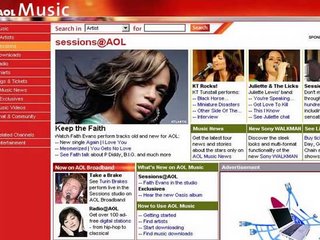
Subscribers to get legal music online
[Micro Mart reports] We reported recently that the likes of Tiscali were attempting to generate an online music download service as the industry looks towards legal, subscription based models. That move can’t be harmed by AOL’s announcement then, that they too are launching a service that will add some weight to the battle against piracy. Not an awful lot, we suspect, but some nonetheless.
Through the MusicNet service, AOL subscribers can pay for tunes from artists such as Elvis, Kylie, Frank, and, er, Justin Timberlake. Pricing is expected to start at around £2.50 a month (that’s four dollars in the States), but that doesn't give you the right to burn any songs to CD. To do that, you need to subscribe to the premium priced service, which costs around £11.50. With that, you have unlimited access to the library, but can only burn ten tunes a month to disc. Hmmm. The service is initially restricted to the US, but a roll out worldwide we suspect is on the cards.
The catalogue to choose from weighs in at a quarter of a million songs, and we’d be interested to hear your thoughts on it through our letters page.
Tuesday, December 19, 2006
Logitech FreePulse Wireless Headphones
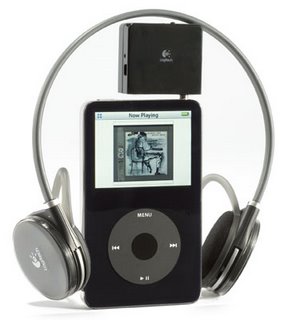 Jamie Ladion from pcmag.com has reviewed the wireless headphone from Logitech.
Jamie Ladion from pcmag.com has reviewed the wireless headphone from Logitech."While millions of people walk around with portable digital music players, I'll bet no one likes the mess of tangled wires they usually come with. Logitech's FreePulse Wireless Headphones eliminate the unwieldy cords—and cost less than $100 to boot ($99.99 list). They're the polar opposites of the Etymotic Ety8; the FreePulse headphones are inexpensive and look great, but sound just average, whereas the Ety8 headphones produce beautifully detailed audio, but are expensive and look a little bizarre.
he FreePulse consists of a pair of over-the-ear headphones, a Bluetooth plug with a 3.5mm stereo jack, and an AC adapter with two charging connectors. It's a sleekly styled pair of essentially traditional headphones, as opposed to the tiny earbuds that come bundled with portable MP3 players and music-capable cell phones these days. Since the headphones sit over the ear, in contrast to in-ear models such as the Ety8, they allow outside noise to leak in. This can be distracting if you're on a loud street or on the subway, but it's also safer when walking outdoors.
These headphones are too large to fit into your pocket; you'll either have to wear them all the time or toss them into a bag when they get in your way. They sport rubber rings for a secure fit, plus a steel-reinforced band that hangs behind your neck. Though they're easy to put on, they didn't sit evenly on my ears and felt a bit tight. No matter how I positioned them, they became irritating after about 45 minutes. I had to readjust them—resetting my comfort clock, if you will—and was then able to listen a little while longer before they became uncomfortable again.
Though the Etymotic Ety8 Bluetooth headphones might look strange, at least their 8-Mate iPod adapter is suitably sleek and lightweight. In contrast, the FreePulse's Bluetooth plug solution is somewhat bulky. The device connects to the headphone jack but doesn't hug the edge of my 5G Apple iPod, and therefore looks like it's going to fall out. In addition, the plug doesn't match most MP3 players' styling or width. Fortunately, you don't need this with Bluetooth devices such as cell phones; it's necessary only for connecting to gadgets that aren't Bluetooth-capable, such as the iPod.
Unlike with the Ety8, you need to charge both the FreePulse headphones and the Bluetooth adapter. The AC adapter splits into two charger connectors in a Y configuration. To charge the system, plug the first connector into the headphones, the second into the Bluetooth plug, and the AC adapter itself into the wall. As the FreePulse costs just one-third as much as the Ety8 with the 8-Mate adapter, all these issues are relatively minor. Also, this type of setup is common among stereo Bluetooth headphones from companies such as IOGear and Anycom.
The right side of the FreePulse headphones contains its controls. There's a power switch that also engages and disengages Logitech's Bass Boost feature, an AC power jack, and a built-in volume control. To adjust the latter, push either the "+" on the top side of the unit or the "-" on the bottom. Track-skip and rewind controls would have been welcome, but you can't have everything.
I found the FreePulse's sound quality essentially indistinguishable from that of the headphones that came with an old Sony Discman or Walkman. With the bass boost engaged, the low end is mostly mid- to upper bass with some punch, adding an artificial weight to the proceedings and giving an approximation of serious bass, but not the real thing. (Without the bass boost, they retain the boom but have no punch at all, so you'll need it). The highs don't reveal the air around instruments; the midrange is balanced and pleasant, but lacks detail. None of this will matter much in everyday listening, but it could frustrate audiophiles.
On the other hand, it was simple to pick out the bass guitar on many tracks, and the FreePulse is evenly tuned; no notes artificially stand out as a bass player moves up and down the scale. The FreePulse is not sensitive to placement; just slap them on and they sound fine. In-ear models such as the Ety8 require a precise fit and careful seal, or they'll sound vastly different (usually much worse) than they're supposed to. And you won't have to deal with cleaning eartips with the FreePulse.
Do the FreePulse headphones sound good enough for casual listening? Sure—and they're wireless, which is the whole point. I was able to walk about 18 feet away from my 5G iPod before I heard regular dropouts. Stepping behind closed doors made it worse. Logitech rates the FreePulse at 6 hours of continuous listening, less than the 6-to-10-hour range that Etymotic gives for the Ety8. In my battery rundown test, the FreePulse lasted 6 hours 22 minutes before beginning a series of musical tones indicating a low battery; they quit another 13 minutes later. That's a decent result, though you might want to carry your MP3 player's stock earbuds in your travel bag as a backup.
Think of the Logitech FreePulse Wireless Headphones this way: You're paying $19.99 for a decent set and $80 for the Bluetooth. As long as you're not expecting audio nirvana, these headphones can do the job nicely."
Monday, December 18, 2006
Top Christmas gift ideas
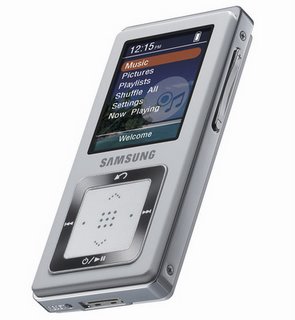
Similar in size to the iPod nano, the Samsung YP-Z5 MP3 player is a popular alternative to the mini-music player. With 4GB of storage, built-in radio and speakers, plus the ability to store and view photos, the Samsung has several advantages over its Apple alternative.
2. Sony Ericsson V630
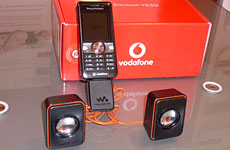
For those that love gadgets and gizmos, this phone is full of them - 2MP camera, video calling, MP3 player, plus these handy portable speakers. This phone offers the latest 3G technology and up to 10MB of storage.
3. Homedics MP3 Massage Cushion
With built in speakers, heat pad and vibrating massagers, the new Homedics MP3 massage cushion can be fitted to any standard office chair or car seat. Just the thing to de-stress when stuck in rush hour traffic or working late at the office. Fitted with a universal audio input, the cushion can be attached to any MP3 player or iPod with an earphone jack.
Friday, December 15, 2006
Transfer iTunes Music to a Zune
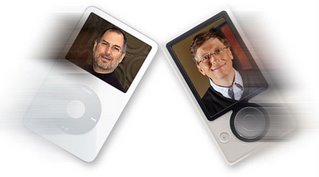
[From tech-recipes] If you have moved from Apple's iPod to Microsoft's Zune, you probably have some songs that you purchased from the iTunes Music Store that you would like to move to the new device. You will run into a hurdle if you try to transfer the files directly as Apple's copy protection prevents the song from playing on another device. There is a workaround to this however...
1. Create a new playlist in iTunes.
2. Add the protected songs to your playlist until you have 72 minutes of music.
3. Click Edit and select Preferences.
4. Select the Advanced tab.
5. Click the radio button next to Audio CD on the Burning tab.
6. Click the Burn Disc button.
7. Upon completion of burning the disc, rip the songs to MP3 using Windows Media Player.
8. Open the Zune software and sync the newly created MP3's to your Zune device.
Wednesday, December 13, 2006
With Zune, The Empire Strikes Back
Call it King Kong vs. Godzilla, Part II.
The huge success of Apple Computer's (AAPL) iPod has drawn the attention of archrival Microsoft. (MSFT)
With the debut of its Zune music player, the software giant wants a piece of the growing market.
So which device is right for you?
As is the case with most tech purchases, it depends.
Apple has dominated the MP3 player market, garnering a 70% share.
"A number of companies have tried to present alternatives to the iPod, but Apple has proved to be too large, powerful and focused," said Samir Bhavnani, research director at Current Analysis.
Other Apple rivals are Creative Tech (CREAF) and SanDisk. (SNDK)
Apple's success has stemmed from several factors, starting with the product's design. The iPod is small, but can store thousands of songs.
Users also like the interface, including Apple's breakthrough Click Wheel, which makes it easy to manage a music library with one hand.
"Apple has long produced devices that offer simple navigation," said Dale Gilliam, a digital media analyst with market research firm Diffusion Group.
Marketing is another strong point. Apple created the right buzz about the product, turning the gadget into a must-have.
Since the product's launch five years ago, the company has been aggressive in fine-tuning and upgrading the iPod.
In October, Apple enhanced the device so that one click shuffles a music library before playback. And high-end models play video games.
The company also has fostered a rich ecosystem of add-ons and adapters that transform the device into a multipurpose gadget.
Apple signed deals with carmakers so the device can be plugged in on the go. Recently, Apple began working with Air France, (AKH) Continental (CAL) and Delta so that business travelers can more easily use the iPod when flying.
In addition, Apple and several outside manufacturers have developed over 3,000 accessories to make the device easier to carry and use.
More Features, Less Music
The Zune resembles the iPod in many ways. The two are similar in size and shape, though the Zune is thicker and has a bigger screen.
One of the Zune's most unusual features is its wireless networking, which lets you share songs, pictures and video with other Zune users. Copied songs will work on friends' Zunes up to three times or three days, whichever comes first.
Eventually, the feature could let you wirelessly use media stored on your home computer or even buy music directly from the device.
The Zune does have its shortcomings. Its capacity tops out at 30 gigabytes. The biggest iPods, while pricier, store more than twice that.
With the ability to store about 7,500 songs, 30 gigabytes might seem like plenty. But space can go quickly, especially when photos and video become part of the mix.
Because the Zune is new, few companies make add-ons. That could make it tough to use it in your car or with your home stereo.
And the Zune's nascent music store sells a limited number of songs and videos.
Uphill Battle
Because of these limitations, Microsoft faces an uphill battle.
"Microsoft will have to provide more compelling reasons for users to switch to Zune," Gilliam said.
History has shown Microsoft to be a formidable competitor willing to invest the time and effort to emerge as a top supplier in new markets.
Take its Xbox video game console. The first version was a strong debut, but failed to woo many from Sony's (SNE) PlayStation 2. The company pressed on with the Xbox 360, which is holding its own in the next-generation console war.
Will the Zune, a project headed by the Microsoft executive who oversaw the Xbox, do the same?
For now, only one thing is certain: This is one sequel worth watching.
Tuesday, December 12, 2006
Studio 60 Christmas song free for download
The New Orleans arrangement of "O Holy Night" that was featured on Studio 60 on the Sunset Strip is available for free download.
A group of New Orleans musicians led by Troy "Trombone Shorty" Andrews played the new version of the Christmas classic as part of "The Christmas Show" episode's story line.
The musicians are really Hurricane Katrina survivors as they played on the show. The vignette was coordinated by the Tipitina's Foundation, an nonprofit organization dedicated to helping New Orleans musicians affected by Katrina.
An MP3 of the song can be streamed or downloaded from NBC's Studio 60 music site.
Saturday, December 09, 2006
Software Review: Play Your Tunes With Pocket Tunes Deluxe

[Software Reviews By: pdaBlast! Staff] Pocket Tunes turns your Palm OS 5.2 device into a portable audio player! Play compressed audio files (MP3, WMA, or Ogg Vorbis) or uncompressed WAV files from a flash memory card or stream music live over your wireless Internet connection.
With its simple interface and ability to play nearly all file types, Pocket Tunes is a full featured audio player. One interesting feature is the ability to stream Shoutcast files. You can stream music from radio stations all over the world right to your PDA. Very cool!
Features:
Fit more music on your handheld with smaller WMA files. (deluxe version only, DRM-protected music downloads are not currently supported)
Copy music faster and easier from Windows Media Player.
Organize your music by artist, album, and genre.
Pocket Tunes can decode any MP3 or Ogg Vorbis file in real time without any skips
or delays.
Listen to ShoutCast audio on your Internet-capable Palm. (deluxe version only)
Pocket Tunes's built-in skin works on all Palms with expandable and rotating screens.
Bring out the best in your music!
Play your tunes while running other Palm applications.
Smoothly transition from one song to the next, like your own personal radio station. (deluxe version only)
Add bookmarks for your eBooks or music so you never lose your place. (deluxe version only)
Pocket Tunes can automatically create bookmarks for you so you never forget where you left off. (deluxe version only)
Control your audio playback from within any application.
On supported devices, Pocket Tunes can turn off the screen while playing to save power.
The Pocket Tunes player interface is completely customizable. Choose from dozens of skins.
The default skin (and many others) take full advantage of the Palm's high-resolution
display with 16-bit graphics.
Play most uncompressed WAV files.
Use the Five-Way navigator control to play, pause, adjust the volume, skip to another song, or select a play list. On the Treo 600, you can use all features of Pocket Tunes without ever touching your stylus.
Create custom play lists to organize your music.
Toggle the shuffle and repeat buttons to change the order your songs are
played.
Adjust the volume and balance as the song is playing.
Quickly seek to any position in a song by sliding the seek bar.
Friday, December 08, 2006
Mobilitybeat, a mobile tech related site, is launched

If you are reading this blog, then you are most likely a fan of mobility. Ryan, from PalmInfocenter, just launched a new site, called MobilityBeat. He published following press release:
"MobilityBeat (www.mobilitybeat.com) is a new community powered website focused on mobile technology. The new website features articles on mobile industry news, product reviews, tutorials, rumors and software. It serves as a user powered content portal specifically focused on covering all forms of the latest mobile tech products including smartphones, PDAs, digital music players, tablets and mobile gadget news.
How does it work?
MobilityBeat at its core is a community powered social bookmarking and link sharing platform. MobilityBeat allows you to submit an article that will be reviewed by all members and will be promoted, based on popularity, to the main page. When a user submits a news article it will be placed in the “queued” area until it gains sufficient votes to be promoted to the main page. Anyone can submit an article and write a brief description, registered users have the ability to vote on stories they like.
In turn, the MobilityBeat users create and decide on the content - creating a unique look at what’s going on in the mobile tech world."
“MobilityBeat aims to be a constantly updated and up to date enthusiast driven website.” remarked MobilityBeat founder Ryan Kairer, “Users will drive the content and help shape the site. I’m a believer in the social news concept and wanted to bring that model to the mobility world.”
link: http://www.mobilitybeat.com
Wednesday, December 06, 2006
Zune, Wii or iPhone?
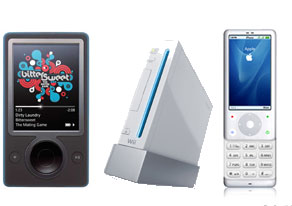
[James R. Stoup from Apples matters reports] "The hype is over, the products are on sale and the verdicts are in. The Zune sucks, the Wii rocks and the Playstation 3 is causing mass hysteria. I, for one, can’t wait until next year when we all can stand in line trying to knife one another over who gets to buy an iPhone.
But taking a slightly more indepth look at things I must pose this question. Was I the only one surprised at the amount of attention the Zune has gotten? Because, virtually without exception, it has garnered poor reviews. The hardware has been opened, the software has been crashed and the experience as a whole has been summed up as mediocre. Contrast this to the Wii. Every report I have read has declared the Wii a winner. But it isn’t getting nearly as much attention as Microsoft’s failed MP3 player. Why?
I keep hearing the oft repeated pearl of wisdom that the Zune is a version 1.0 device and that Microsoft doesn’t actually produce a meaningful product until its third release. Which would put this new Zune 3.0 somewhere between 2-3 years into the future. Am I the only one who is skeptical of this nonsense? Are these pundits really thinking that Microsoft will continually lose money for at least 2 years before coming up with a competitor to today’s iPod? Isn’t it a bit more likely that the Zune will just die a slow and quiet death just like Plays-For-Sure? Am I missing something here?
But getting back to Nintendo and their amazing new console I would like to ruminate for a moment. For those of you who haven’t actually played with a Wii, let me tell you, they are cool. Really cool. Like, you will probably be buying one in the next year, kind-of cool. So doesn’t this officially signal the decline of the standard two joystick controller? You can already see that Sony is trying to jump on board with its novice attempt at including motion sensing technology in its controllers. But what about Microsoft? The Xbox 360 has only been out for a year and its going to be a long time (as far as the video game industry is concerned) before the Xbox 720 (or whatever its to be called) comes out.
This means that Microsoft can either pull a Sony and attempt some cheap bolt-on motion sensor knock-off so it can join the “me-too” crowd. Or it has to wait until the next console comes out and start afresh there. Neither option is really all that attractive. Because on one hand you have Microsoft adding yet another piece to the Xbox system (remember, it already has a snap-on harddrive and a plug-in HD-DVD player so by all means, bolt some more crap onto it) but that will take time to develop, it will be buggy initially and will still seem cheap in comparision to Nintendo. While on the other hand waiting till the next Xbox comes out means that the current system will continue to loose money and marketshare.
Meanwhile Sony is in a better position, but not by much. They have all of Microsoft’s problems, just to a lesser degree. They too need to examine how they are going to move forward with new input devices. And they too need to get consumers on their new High Def format (which in this case is Blu-Ray) but at least the Playstation has the benefit of having an integrated Blu-Ray player and superior graphics as compared to the other consoles. However, while the difference between the Wii’s graphics and the Xbox or PS3 is quite noticable, the difference between the Xbox and PS3 isn’t nearly as dramatic. It should make things interesting to say the least.
As for myself, I will definately get a Wii after the Christmas rush. And whenever Halo 3 comes out I will then go buy an Xbox 360. As for Sony? Sorry, this consumer doesn’t have a compeling enough reason to go out and buy a PS3. Better luck on the PS4.
Mp3 Freebie (2.000.000 Songs Database!)
Apple launches iTunes, online stores in New Zealand
The Cupertino, Calif.-based company also opened the online Apple Store New Zealand, where customers can quickly and conveniently purchase Apple’s complete lineup of innovative products, including iPods, Intel based Mac desktop and notebook computers, the iLife ‘06 suite of digital lifestyle applications, a vast assortment of iPod and Mac accessories.
"We’re thrilled to bring the iTunes Store and the online Apple Store to our customers in New Zealand just in time for the holidays," said Eddy Cue, Apple’s vice president of iTunes. "With over two million songs, the iTunes Store features the largest catalogue of local and international music in New Zealand, and with the new online Apple Store, it’s easier than ever to shop for everything from a personally engraved iPod to a customized Mac."
With a catalogue of over two million songs, the iTunes Store features the most music of any digital music store in New Zealand with songs priced at just NZ$1.79, music videos at NZ$3.59 and most albums at NZ$17.99.
Exclusive music featured on iTunes includes tracks from New Zealand artists Fat Freddy’s Drop, Brooke Fraser, Tim Finn, The Datsuns and Bic Runga as well as extensive catalogues from New Zealand greats including Shihad, Crowded House, The Black Seeds, Breaks Co-Op, Elemeno P and Dei Hamo.
International exclusives on iTunes include albums from The Doors, Faithless, Incubus, Foo Fighters, George Michael and more. The iTunes Store features iTunes Originals from international stars Red Hot Chili Peppers, Ben Harper, Black Eyed Peas and Jack Johnson. The iTunes podcast directory currently features over 65,000 podcasts, including featured New Zealand podcasts from TVNZ, The Voice Booth and Radio NZ.
At the online Apple Store New Zealand, customers can browse and purchase Apple hardware, software, accessories and a large selection of third party products with just a few clicks of a mouse, the company said. Customers can custom engrave any iPod through the store, and can easily custom configure their Mac to suit their individual needs. The online Apple Store also offers special education pricing to teachers and university and college students.
Additionally, Apple announced that the iPod nano (PRODUCT) RED Special Edition is now available in New Zealand, only at the new online Apple Store. Available in 4GB and 8GB models, the player comes in a red aluminum enclosure and features up to 24 hours of battery life, Apple’s Click Wheel and an incredibly thin and light design.
Tuesday, December 05, 2006
MP3! Second Edition - I Didn't Know You Could Do That...
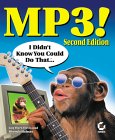
[A book recommendation for you!... brought to you by MusiciansBooks and Amazon] After sex, the second hottest topic on the Web is MP3, the audio compression format that lets you store and play music on computers and distribute it swiftly and easily over the Internet. This book shows you how to use MP3, how to get the most out of rippers, players, and audio editors, how to record and distribute your own music online, how to troubleshoot MP3, and much more! It includes a valuable CD jam-packed with MP3 goodies including all the software the serious music fan needs to create, play back, and edit MP3 files, together with music and audio in MP3 format.
Monday, December 04, 2006
Liquid Tunes Waterproof MP3 Players

[Newscut.com reports]"This unit is simple to operate, easily downloads music, is very lightweight, skip free, and most importantly durable.
The patent pending, Liquid Force exclusive, MP3 player and ear buds are 100% waterproof. No extra case necessary. Shane Bonifay and our other team riders swear by it. Try one for yourself and you'll instantly be a believer. Liquid Tunes™ guaranteed to rock every session on the water! "
Liquid Tunes™ comes complete with hardware and software to change the way you ride forever. For your favorite riders play list or more detailed specs, visit: www.liquidforce.com
• 1 Gig… $199.99
• 512 MB… $169.99
• 256 MB… $139.99
Liquid Force
364 2nd Street Suite #7
Encinitas, CA 92024
1-800-820-7781
Sunday, December 03, 2006
How To Buy An MP3 Player
The jWIN has performed very well. I have no real complaints about it for the price.
However, I’ve been very reluctant to invest in a bigger SD card despite the fact several times a week I cycle different songs onto the card. If I got a 1GB SD card, I could stop this song swapping. But I don’t think the result would be a satisfying experience. I’ll explain why at the end of this.
Since many people will be buying MP3 players for holiday gifts, I thought I’d detail my own conclusions about what makes the best MP3 player. I think this could save people some grief and help prevent giving someone an ultimately disappointing gift.
These are the main considerations in choosing an MP3 player:
1) How much will the player be used?
2) How big is the MP3 collection?
3) What is the player’s battery life?
4) How will the player be treated?
5) Is a built-in radio important?
6) Does the player offer optional additional storage?
7) Can the player be used for more than MP3?
8) How does the player navigate files?
How much will the player be used?
Buying the jWIN was mostly an experiment for me. I’d listened to MP3s on the Palm and a previous Pocket PC, but these were not devices dedicated to just playing back MP3s. When I listened to MP3s on them, it was to pass the time or to have some variety of use. How much would I really use an actual MP3 player?
As it turned out, plenty!
When I came across the music of Girls Don’t Cry, it really changed everything for me. This was music I really wanted to hear every day (and I just about have!). Prior to them, I’d listen to The Smiths, Morrissey, some ABBA, a mixture of single songs, and soundtrack music by Barry Gray and others. As compelling as these were, they weren’t every day music. So in considering a player, I think it’s important that it’s something that will be used just about every day, especially if it’s expensive.
How big is the MP3 collection?
Prior to the Girls, though, I ran into another consideration in choosing a player: The size of one’s music collection. Mine is about 8GB right now (although there are duplicates due to different encoding bit rates). But this is just music. I also have another 4GB of non-music MP3s. And this brings up the second point to consider: collections tend to grow to the size of storage capacity.
As I mentioned earlier, I’ve been cycling songs onto the 128MB SD card several times a week. This gets annoying very fast, even at USB 2.0 speeds (I use a separate card r/w device because the jWIN is just USB 1.0). So an MP3 player should have not just sufficient capacity to hold a large variety of music, but it should also have plenty of room to grow.
Although most MP3 players are bought simply with existing music collections in mind, it’s important to also consider the variety of other MP3-based files that are available. There are thousands of [p]odcasts. There are also speeches (I have several World War II broadcasts by Churchill) and lectures, Old Time Radio dramas (Sherlock Holmes) and comedies (W.C. Fields and Charlie McCarthy), plus instructional programming (despite the terror campaign by the RIAA, there is plenty of legal, free, and public domain material available via P2P). A player should have a depth of storage for both existing and future needs. Why buy a player that can soon be outgrown?
What is the player’s battery life?
My jWIN uses a AAA battery. In the beginning, this was convenient. I wouldn’t have to worry about being near an AC outlet or carrying an AC adapter. This has been a false economy, however. I’ve now easily spent probably double the price of the player in AAA batteries. At times I’ve run through a battery in a single day. How much power is used is mainly determined by the bit rate of an MP3. The higher the bit rate (and hence the larger the file), the more electrons are gobbled. MP3 players that rely on flash memory have better battery life than players that use a hard drive. So an iPod nano will keep going long after a fifth-generation iPod-with-video dies. Although a player that uses off-the-shelf batteries seems appealing, I can’t recommend buying one after my own experience.
How will the player be treated?
Durability can be a requirement for some people. I’ve had no complaints about the jWIN in this area. I carry it around in a jacket pocket with several other items (such as its USB cable! — the jWIN can also function as a card r/w). The only consequence of this has been its serial number (which is on a sticker) getting worn away. Other than that, it hasn’t been prone to scratching. Durability is a factor if an MP3 player is going to be used during a physical activity, like jogging. Players that use flash memory are best in this respect. A player with a hard drive is too fragile to place in an active environment.
Is a built-in radio important?
Sometimes, even with a very large collection of music, a change is desired. Listening to a built-in FM radio can offer some variety. Until I saw the way an FM radio is done on the Zune, I didn’t think I’d want one. I would now if it was possible to have the same FM radio features the Zune offers (station ID, song title and artist, etc). The quality of a built-in radio will depend upon the tuner components used, the use of wired earphones (the wiring acts as the radio’s antenna), and the location of the player itself (midtown Manhattan offers a lot of radio interference!). Aside from a built-in radio, another possible feature to consider is the ability to record from the radio on the player itself. Not every player with a built-in radio has this ability.
Does the player offer optional additional storage?
This feature allows the possibility of initially buying the least expensive player in a model line. Several players now offer microSD card slots to supplement their on-board storage. This makes it possible to, say, buy a 2GB player now and then add another 1, 2, or 4GB later on as card prices continue to plummet. Overall, this is a good deal that can prolong the usefulness of the player.
Can the player be used for more than MP3?
The jWIN, basically really being a card r/w device that can also play MP3s, will allow me to put any file that can be put on an SD: text, photo, etc. But the jWIN can’t do anything with those files. Players have evolved to the point where they offer more than just MP3 (and, when offered, FM radio) playback. A player such as the iPod (all models) can now act as a repository for contacts, appointments, ebooks, and photos. The large 5G iPods also play video. The Sandisk Sansa e200 series, that company’s iPod nano competitor, can play video on its tiny screen. It might seem ridiculous, the idea of video on such a small screen, but owners love the fact they can drop episodes of The Simpsons on it (cartoons, with their bold colors and large images, look particularly good on a small screen). The drawback to video is that it uses much more power than MP3 playback. A player rated with a 12-hour battery life for playing MP3s can need recharging after just 2 hours of playing video. At the very least, I think having contacts on a player is important as a backup to the contact list on one’s cellphone.
How does the player navigate files?
Although this question comes last, it’s actually the most important consideration and explains why I don’t think I’ll be getting a larger SD card for my jWIN. To move from song to song on the jWIN, I have to move its center microjoystick either left or right (like the Zune, what looks like a wheel isn’t). Even with 25 songs on a card, this gets irritating fairly quickly. I then imagined what it would be like if I sprung for a 1GB SD card and had several hundred songs: a nightmare! If I was at song 50 and wanted to listen to song 142 next, I’d have to form a blister on my thumb to do so! Being able to go through a directory of several hundred — if not several thousand — files has to be the most important consideration when choosing a player. There is just no substitute for a wheel like that offered on the iPod or the Sansa e200 series. Second best is a pushbutton combined with software that’s designed to zip through directories quickly (such as on the Zune). Look for an interface that allows files to be arranged under a variety of categories, such as by Artist, Album, Genre, etc. The jWIN puts all files in one long list with no possibility of arranging them in catgeroies.
Summing up all of my thinking:
An MP3 player should be looked on as an investment and how much it will be used should be a factor in how much to pay for it. But stay away from cheap players that use disposable batteries; they’re really no bargain. A player’s storage capacity should at least match that of an MP3 collection; ideally, it should be larger than the collection and offer additional storage capability. Avoid players that have a hard drive if it’s expected to see rough handling. A built-in radio is a good feature to have but its true value will depend on several factors, not all of which can guarantee a worthwhile experience. Players that can do more than just play MP3s are better buys. But most of all, start out by looking at players that will allow moving through a large collection of files quickly; having to put too much effort into playing a song will quickly lead to the player being put up for sale on ebay or away in a drawer — and that’s not the kind of present someone wants to give or get!"
Friday, December 01, 2006
Apple iPhone Patent Granted
 Gizmodo is reporting "The evidence keeps stacking up about the upcoming iPhone, and now a patent was granted to Apple this morning, referring to a handheld computing device, specifically a cellphone and media player combination. It looks a whole lot like the iPod mini and the current second-gen nano, doesn't it? Apple notes that it could have more controls than just its click wheel, meaning perhaps a trackball or keypad as well."
Gizmodo is reporting "The evidence keeps stacking up about the upcoming iPhone, and now a patent was granted to Apple this morning, referring to a handheld computing device, specifically a cellphone and media player combination. It looks a whole lot like the iPod mini and the current second-gen nano, doesn't it? Apple notes that it could have more controls than just its click wheel, meaning perhaps a trackball or keypad as well."














